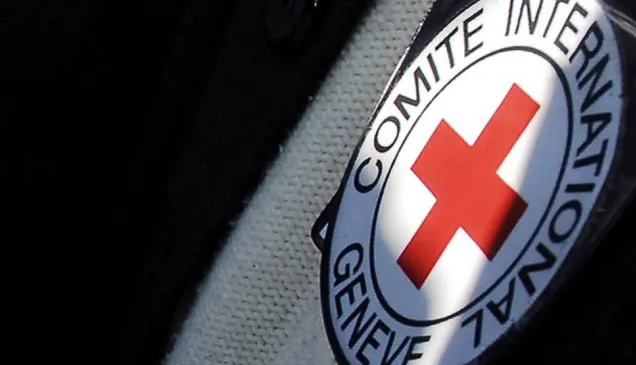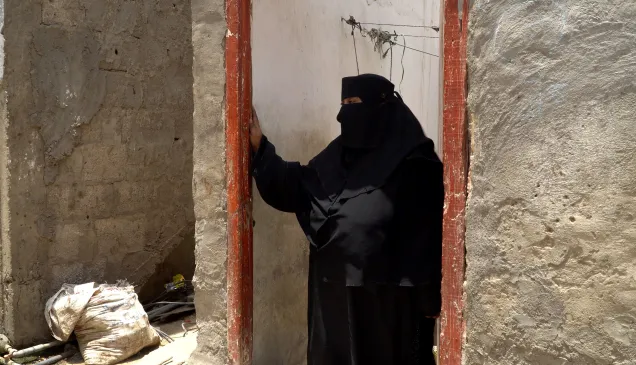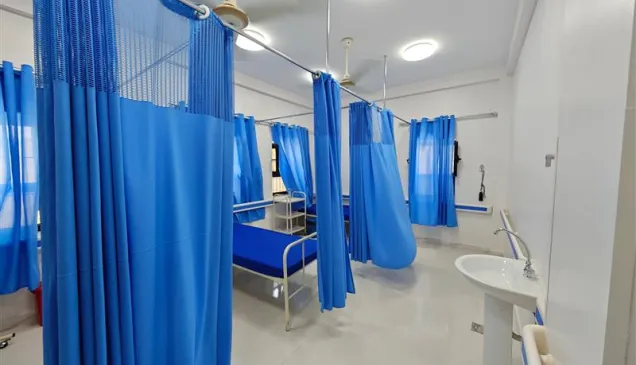Red Cross and Red Crescent relief aid in Yemen
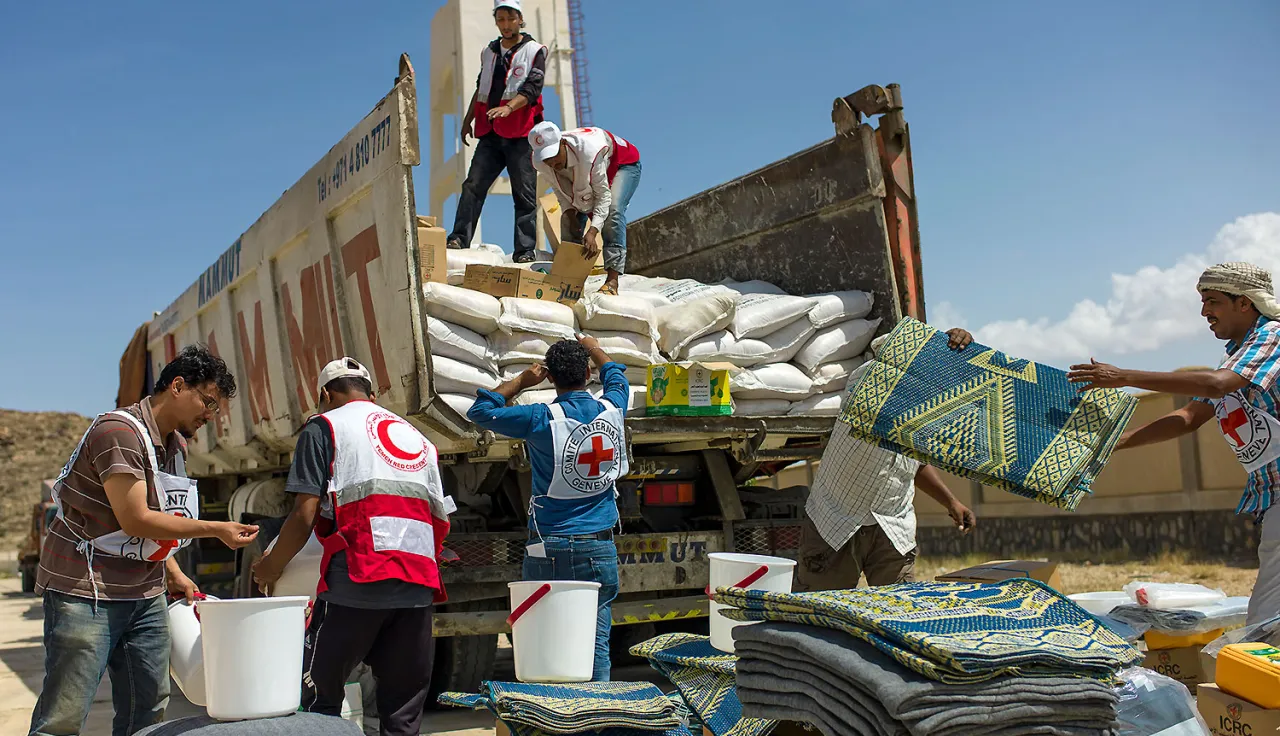
All aspects of life have been impacted in Yemen. Death and displacement have become daily occurrences. Food imports are critically low, essential municipal services including electricity and water are disrupted, and health-care services are severely affected. The International Red Cross and Red Crescent Movement (Movement) continues to work hard to respond to the pressing humanitarian needs.
Movement's joint response to the crisis in Yemen
Members of the Movement are working together to tackle the humanitarian crisis in Yemen.
With its 250 staff members in the country, the ICRC leads and coordinates the Movement's response on the ground, often working hand in hand with, and providing substantial support to, the Yemen Red Crescent Society (YRCS).
Meanwhile, the International Federation of Red Cross and Red Crescent Societies (International Federation), with the ICRC's financial support, continues to provide various forms of capacity building and support to the YRCS through its Yemen Development Plan and its representatives on the ground. It also continues to raise funds to cover the acute and growing humanitarian needs in the country.
Other National Red Cross and Red Crescent Societies are also contributing to the joint response by providing generous financial and in-kind support to the YRCS and the ICRC and by seconding specialists to the field through the ICRC. National Societies are also delivering health care and other services to Yemenis who have fled the conflict and found refuge in their respective countries, such as helping them get back in touch with their families.
Humanitarian situation in Yemen
On average 30 people are killed and 180 injured every day in Yemen [1]. Visiting the country in August to see the situation first-hand, ICRC President Peter Maurer described the humanitarian situation in Yemen as "nothing short of catastrophic."
Intense ground fighting coupled with continued airstrikes and indiscriminate shelling in a number of governorates, including Taiz, Ibb, Al-Dhale' and Marib, have caused many casualties and triggered large waves of displacement (1.4 million people are currently displaced).
In a number of areas, such as Taiz, the fighting has put enormous strain on the handful of hospitals still functioning and made the delivery of life-saving medical and surgical supplies extremely difficult. Extensive damage has also been done to vital infrastructure, including sea ports, airports and health-care facilities.
During August, the overall health-care situation in the country deteriorated further as even more health-care facilities were damaged (23% of health-care facilities have now been destroyed according to the Ministry of Public Health and Population).
Severe shortages of medical and surgical supplies are prevalent in the worst-affected areas and people encounter serious difficulties in accessing health-care services owing to ongoing fighting.
The retrieval of dead bodies also continues to be a major concern, with dead bodies often left lying in the street in the fighting hotspots for several days, which then complicates the identification process. Communicable diseases such as dengue fever are at a record high in Taiz governorate, affecting over 17,500 people according to government figures. Malaria and diarrhoea are also on the rise in Sa'ada governorate.

Staff from the ICRC and the Yemeni Red Crescent Society (YRCS) help to collect and transport the bodies of people who died due to fighting. / CC BY-NC-ND/ICRC/O. Chassot
Safe access for health-care personnel and aid workers continues to be a major challenge. Red Cross and Red Crescent staff and volunteers are increasingly having to take great risks and put themselves in harm's way to carry out their work. Following an attack on its offices on 24 August, the ICRC had to temporarily suspend its activities in Aden. The YRCS has also had to close its office in Taiz following recurrent attacks and looting of its premises. In early August, a YRCS volunteer was injured while providing first aid to the wounded in Al-Dhale' governorate. Then came the shocking and brutal killing of two ICRC staff members on 2 September while on their way from Sa'ada to Sana'a, leading the ICRC to temporarily suspend its activities nationwide.
Key facts and figures
In spite of an extremely challenging security situation, the Movement was able to carry out the following activities in August:
- Life-saving medical and surgical supplies to treat thousands of patients were delivered by the ICRC to three health-care facilities in Sa'ada, Taiz and Ibb. An ICRC ship carrying medical supplies also arrived in Aden.
- More than 120 dead bodies were collected by the YRCS in the governorates worst affected by fighting and handed over to hospitals or the relevant authorities.
- The YRCS branches in Aden, Abyan, Lahj, Al-Dhale', Shabwah and Ibb provided first aid to more than 30 injured people on the spot and took over 100 people to hospitals; a YRCS medical team in Abyan treated 10 injured fighters and took two to hospital in Aden.
- More than 65,000 displaced people received various forms of assistance, including food and household items, through various distributions in Al-Jawf, Sana'a, Sa'ada, Amran and Aden.
- 22 water distribution points were installed in various locations in Sana'a to serve some 15,000 people.
- The Sudanese Red Crescent Society dispatched medical supplies to Aden and seconded several health specialists to conduct an assessment of surgical needs in southern Yemen.
- The YRCS branch in Aden received a fully equipped ambulance donated by the International Federation.
- The YRCS branch in Amran ran psychological support sessions for more than 150 local and displaced people.
- The ICRC was able to negotiate safe access for vaccinators in Al-Bayda governorate as part of a national polio and measles vaccination campaign conducted by the Ministry of Public Health and Population in coordination with international organizations.
- A total of 14 released prisoners were taken home by the ICRC, either from Sana'a to Aden or from Aden to Sana'a.
- With German Red Cross and ICRC support, the YRCS headquarters team organized training in first aid and weapon contamination for 30 participants from various districts of Sa'ada governorate.
- On 24 August, the Arab Red Crescent and Red Cross Organization (ARCO) convened a meeting in Riyadh to share information on the situation in Yemen. The meeting brought together officials and representatives of the King Salman Centers, the Saudi-led Coalition, various United Nations agencies, charities, National Societies (of Saudi Arabia, Kuwait, Qatar, United Arab Emirates, Djibouti, Jordan, Sudan and Egypt), the ICRC and the International Federation.
- The Red Crescent Society of the United Arab Emirates launched a major television fundraising campaign in early September with the slogan "Yemen, We Care," with the aim of coming to the aid of 10 million Yemenis. Over 15 million US dollars were raised. So far, the Society has provided more than 15,000 tonnes of relief to at least 620,000 persons in Yemen. It has also allocated 50 million United Arab Emirates dirhams to water projects in the country, provided generators and started rebuilding and repairing schools.
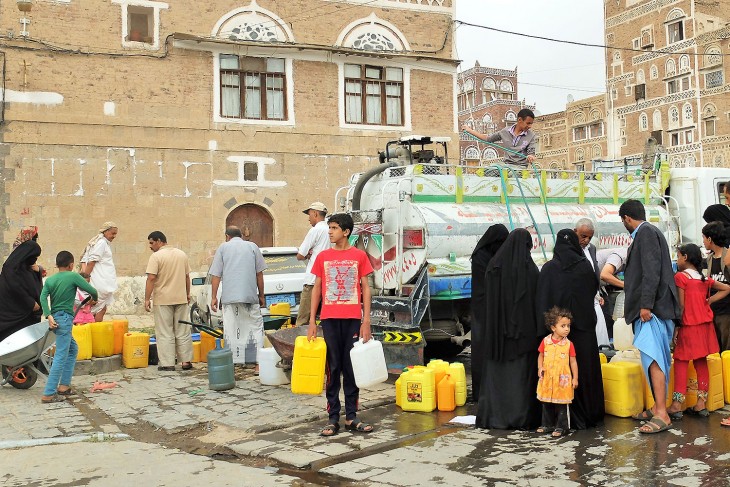
Old City, Sana'a, Yemen. As Yemen continues to battle water shortages, many people are dependent on water delivered by tankers. In August 2015, the ICRC continued to deliver water to several hospitals and set up 22 water distribution points in Sana'a, giving 15,000 people clean drinking water. / CC BY-NC-ND/ICRC/S. Ammane
Notes
1. Based on 4,628 people killed and over 28,598 injured from 19 March to 30 August (Ministry of Public Health and Population figures).

